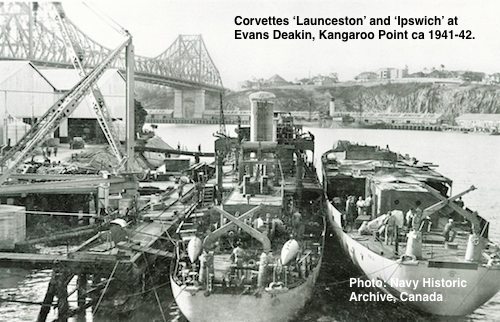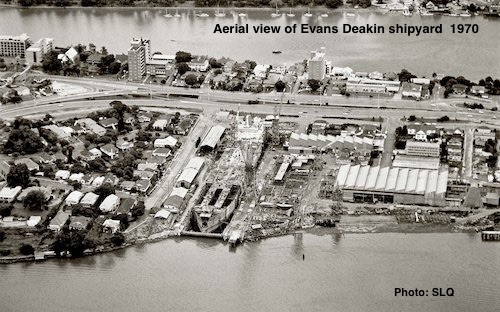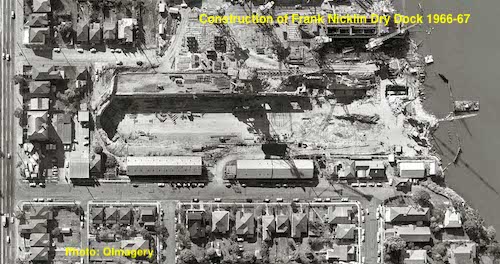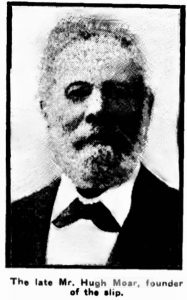EVANS DEAKIN SHIPYARDS




MOAR’S SLIP – 78 Cairns St, Kangaroo Point (today Frank Nicklin Dry Dock)
PART 1: 1884 – 1928 THE MOAR FAMILY AND MOAR’S SLIP
The story of Moar’s Slip is the story of the Moar family, pioneers in the early maritime history of Brisbane; and Evans Deakin Industries, shipbuilders during WWII. It is set in the days when Kangaroo Point was a busy industrial, engineering and shipping area.

Hugh Leask Moar (1838-1914) was the son of a shipbuilder’s draughtsman and grew up in Stromness, a seaport town in the Orkney Islands in Scotland. He worked as a shipwright and ship’s carpenter. In 1862 he and his future wife, Martha, came to Queensland on the barque Rajasthan. They landed at the old Immigration Depot in William Street. Soon after they married and settled down in a small house in John Street (now Rotherham Street), Kangaroo Point. Hugh became a ferry operator after putting in a successful bid for the right to operate the Edward Street to Thornton Street, and later also the Customs House ferry.
His interest in local shipping began in 1880 with a casual conversation when A.R. Jones, the owner of a ship chandlery store in Eagle Street, said to him: “Well, Moar, I don’t see that I can make any use of that acre of land of mine over your way. I will let you have it for what I gave for it.” The land was at the river end of Cairns Street, in the area which is now Dockside, down from Peters Slip (the first slip built in 1873). Jones had paid c. £280 for it at the Shafston Estate sale in December 1874. Moar readily accepted the offer as he could see the land and location were ideal for a new slip which he could build there.

First he built a new two-storey home on the highest corner of his land at 96 Cairns Street, a well-chosen location which was not affected by the great flood of 1893. He called it Stromness after his home town in Scotland. Mrs Moar established a beautiful garden which went right down to the ship yard. They had seven children, but two died in infancy.
In the following year, 1881, Moar began excavations for a slip between Cairns Street and Prospect Street. According to news reports of the day, it was hard work for the men to dig the rock for the basin. They worked every day from 8 to 5, (8 to 4 on Saturdays) for about 6 shillings (60 cents) per day. Draymen with their own drays earned from 11 to 12 shillings ($1.10 ) per day. The men were glad to get the work and Mr Moar was a fair and well-liked employer.

The new slip was completed in 1884 and was known as Moar’s Slip. It helped to consolidate the local shipping industry by providing job opportunities for wharf and ship workers. It also became a successful family business for three generations of the Moar family: Hugh Moar, until his death in 1914; his eldest son William James Moar until his death in 1924; then Miss Moar and Reuben V H Moar until the business eventually closed in January 1928.
The first ship to enter the new slip was the small steam ship, the Fanny, captained by John Burke, founder of the John Burke shipping line. Charges were waived to mark the occasion. The Queensland Steamship Company’s Taldora was the first paying customer, followed by many others over the years. Their main clients were the Redbank Meat Works, Burke and Sons, and W. Collin. Work required by the Town Council was shared with Peters Slip.
Moar’s Slip operated continuously for 44 years until it closed in 1928. However, it would live on for many more years fulfilling a different yet important role in local maritime history.
In 1929 the Brisbane City Council bought the slip for £ 5,500 to be used to overhaul the ferries, but this never eventuated. Council did not buy the family home Stromness and it remained the family home until c 1940 when it was used as an office for Evans Deakin. In 1964 Stromness was moved to the Early Street Historical Village and, when that closed in 1998, it was moved to Mt Tamborine. (more on this to come)
Coming up: What happened to Stromness? and Part 2: Moar’s slip becomes shipyard for Evans Deakin to build military and merchant vessels for WWII.
(sources: SLQ/BCC Heritage Register/Trove articles/personal archives)
